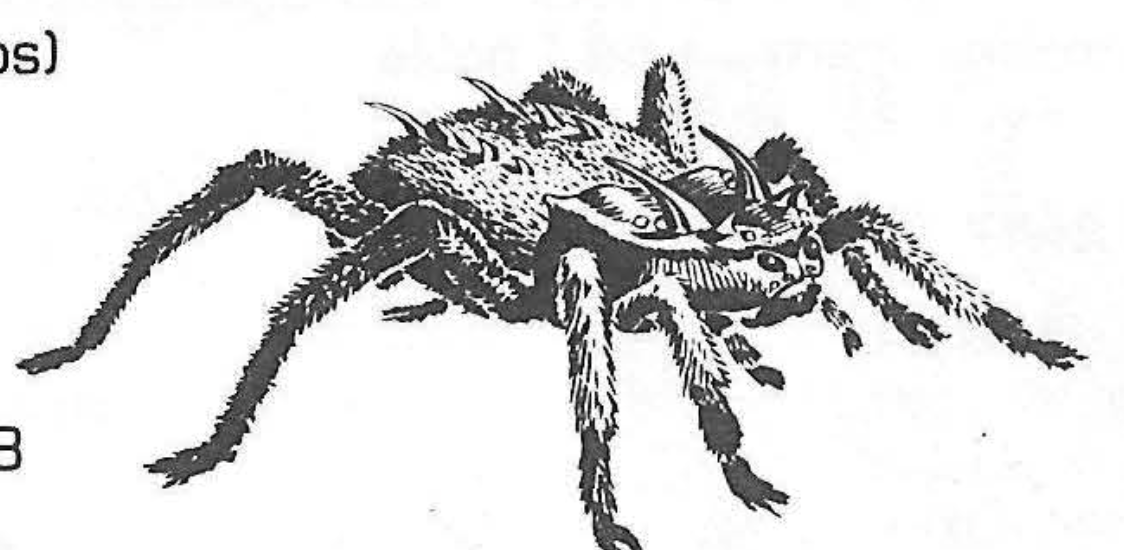Wandering Blackuns «Attercop Abulare»

Creature Metadata
- Reported By
- James M. Ward
- Source
- 0th Edition - Metamorphosis Alpha
- Role
- Monster - Domesticatable
- Base Stock
- Garden Spider
- MCC Stat Block
- Attercop Abulare 'Wandering Blackuns' (1d4 (2)): Init +2; atk bite melee +2 (1d4+1); AC 16; HD 3D7 hp 12 each; MV 50' ; 1d20; SV Fort +0, Ref +0, Will +1
- Mutations
- (P) Electrical generation (14),(M)Immune to mental Attacks except Illusion
Combat & Physical Stats
- Number Appearing
- 1d4
- Morale
- 14
- Hit Dice
- HD 3D7
- Armor
- 6 (AC 16)
- Size
- Small 1.5 Meter
- Movement
- MV 50'
- Attack
- Bite melee +2 (1d4+1)
Ability Scores
- MS:
- 15
- PS:
- 15
- IN:
- 3
- DX:
- 10
- CH:
- 3
- CN:
- 10
Ecology & Logistics
- Frequency
- Common
- Organization
- Solitary
- Activity Cycle
- Any
- Diet
- Carnivore
- Habitat
- Any Temperate or Tropical
- Tech Level
- 0 - 0
- Artifacts
- D
Description (Initial Observations): Attercops, also known as Blackuns, are mutated garden spiders. They have long bristles across their bodies, making them unpalatable prey to all but the largest creatures. They have 12 eyes located all over their head, giving them 360 degree sight.
Description (Additional Observations): Attercops Abulare, also known as Wandering Blackuns, are mutated garden spiders. They have long bristles across their bodies, making them unpalatable prey to all but the largest creatures. They have 12 eyes located all over their head, giving them 360 degree sight.
Behavior & Society
- Reactions
- No known interactions
- Behavior
- Behavior modeling incomplete
- Repair & Healing
- Behavior not recorded
- Society
- The attercop is a solitary hunter, allowing no others of its kind within its web or territory except during fall breeding, Female Attercops deposit a half-meter diameter egg sac containing over 1000 young. Blights, bloodbirds and carrins hunt these young Attercops, liking all but a few dozen before they are large enough to defend themselves. The Attercop's flame resistant web sometimes stretches over an area of 60 meters in diameter. Creatures captured in the web need to make a DC 5 strength check to escape. Any loot found in an Attercop's web is merely indigestible waste to the spider. The Lil, commonly take refuge within or behind attercop webs, although some fall prey to the spider.
Additional Creatures
0th Edition - Metamorphosis Alpha
1st Edition
2nd Edition
3rd Edition
4th Edition
5th Edition
6th Edition
6th Edition - Beyond the Horizon
6th Edition - Machines & Mutants
Badder to the Bone
Badder to the Bone II
Dragon 98 - Ares Section June 1985 - GW2
Dragon Magainze 085
Dragon Magainze 130
Dragon Magazine 075
Dragon Magazine 098
Dragon Magazine 104
Dragon Magazine 108
Dragon Magazine 113
Dragon Magazine 126
Dragon Magazine 130
Famine at Fargo 7th Edition
GW01 - The Legion of Gold
GW02 - Famine in Far-Go
GW03 - The Cleansing War of Garik Blackhand
GW04 - The Mind Masters
GW05
GW05 - Rapture of the Deep
GW06 Module
GW06 Module, MM2
GW07 Module
GW08 Module
GW09 Module
GW10 Module
METAMORPHOSIS ALPHA TO OMEGA ADVENTURE 1: The Quest for Elvis
MM2
Master's of the Earth Campaign: MA-1 The Trials
Master's of the Earth Campaign: MA-4 To the Rescue
Master's of the Earth Campaign: MA-5 The Savage Beast
Master's of the Earth Campaign: MA-6 City of the Ancients
Masters of the Earth Campaign: MA-2 The Town of Boze
Mud Glat Walker
Omega Project
Paths of the Lil in White Dwarf
Polyhedron 02
Polyhedron 03
Polyhedron 10
Polyhedron 14
Polyhedron 144
Polyhedron 15
Polyhedron 27
Polyhedron 44
Ted Tschopp
The Albuquerque Starport
The Barracks Raid
There will be War
Trouble in Freesboro
White Wolf: Midnight in the Mystery Garden
Webmentions
Connect your blog or website to this post via Webmentions. Link to this article and your response will appear below, fostering a web-wide discussion. Supports comments, likes, and reposts from any Webmention-enabled site.